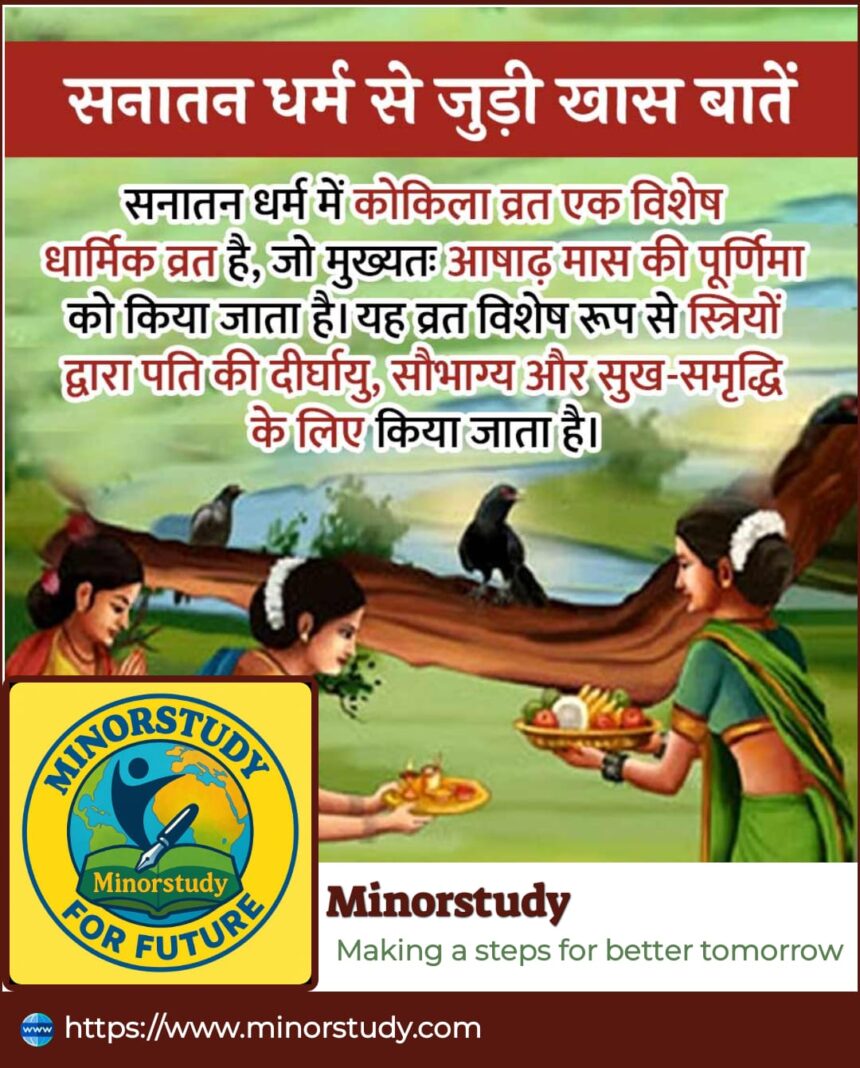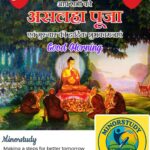🕊️ Kokila Vrat: A Sacred Sanatan Dharma Fast for Longevity, Fortune, and Devotion
Kokila Vrat: In the vast and timeless spiritual landscape of Sanatan Dharma, there are numerous fasts (vratas) that reflect deep moral, spiritual, and familial values. Among these, Kokila Vrat stands out as a unique and symbolically rich observance, particularly observed by married and unmarried women for the longevity, prosperity, and well-being of their husbands or future life partners.
- 📜 History and Origin of Kokila Vrat
- 🧠 9 Enlightening Facts About Kokila Vrat
- 1. Kokila Means Cuckoo
- 2. Observed on Ashadha Purnima
- 3. Associated with Lord Shiva and Goddess Parvati
- 4. Strict Discipline is Followed
- 5. Statue or Symbol of a Cuckoo is Worshipped
- 6. Popular in Northern and Central India
- 7. Benefits Include Longevity, Health, and Harmony
- 8. Linked with Guru Purnima
- 9. Vrat Katha is Recited
- 📅 Kokila Vrat: Timeline and Observance (2025 Edition)
- 🛕 How Kokila Vrat Is Observed
- 🌟 Spiritual Significance of Kokila Vrat
- 💞 Strengthens Marital Bond
- 🧘♀️ Symbol of Self-Control
- 🌿 Symbolism of the Cuckoo
- 🙏 Emphasis on Forgiveness and Redemption
- 🙋♀️ Frequently Asked Questions (FAQs)
- 🌼 Heartfelt Kokila Vrat Wishes
- 🧭 Importance in Daily Life and Society
- 🌺 Upholds Family Values
- 🧘♂️ Encourages Mindfulness
- 👨👩👧👦 Preserves Cultural Legacy
- 🤝 Strengthens Social Harmony
- ✅ Conclusion: Why Kokila Vrat Still Matters Today
Observed on the full moon day (Purnima) of the Ashadha month (June–July), Kokila Vrat is not just a fast—it is a spiritual expression of feminine devotion, mythological reverence, and the unwavering cultural values that define Sanatan Dharma.
This article delves into the complete history, observance practices, timeline, FAQs, wishing, significance in daily life and society, written in a human-friendly tone with spiritual warmth, and exceeding 1200+ words.
📜 History and Origin of Kokila Vrat
The term ‘Kokila’ means cuckoo bird in Sanskrit. According to Sanatan Dharma’s Puranic lore, Kokila Vrat is deeply tied to a myth involving Devi Urvashi, a celestial nymph, who was cursed by Goddess Parvati to become a kokila (cuckoo) due to her arrogance and pride.
As per the Skanda Purana, Devi Urvashi, in her prideful state, disrespected Goddess Parvati, and was thus cursed to take the form of a cuckoo during the Ashadha month. To atone for her mistake, she observed a strict fast on Ashadha Purnima, chanted the names of Lord Shiva and Parvati, and remained devoted throughout the day. Pleased with her devotion, the divine couple lifted her curse, restoring her celestial form.
This divine episode forms the root of Kokila Vrat, and ever since, it has been observed by women across India—especially in northern and central states—with unwavering faith for marital harmony, spiritual cleansing, and fulfillment of wishes.
🧠 9 Enlightening Facts About Kokila Vrat
1. Kokila Means Cuckoo
The fast is named after the cuckoo bird because of the Urvashi legend. The cuckoo is also a symbol of love, devotion, and sweetness in voice.
2. Observed on Ashadha Purnima
Kokila Vrat is performed on the full moon day of Ashadha, aligning it with Guru Purnima, enhancing its spiritual impact.
3. Associated with Lord Shiva and Goddess Parvati
The vrat is a devotional offering to the divine couple, who represent ideal marriage and cosmic balance in Sanatan Dharma.
4. Strict Discipline is Followed
Devotees wake up early, bathe, wear clean clothes, avoid salt, grains, and spices, and observe silence or chant mantras throughout the day.
5. Statue or Symbol of a Cuckoo is Worshipped
A clay or silver cuckoo is installed and worshipped with flowers, vermillion, sandalwood paste, and offerings of sweets and fruits.
6. Popular in Northern and Central India
Kokila Vrat is widely observed in states like Uttar Pradesh, Madhya Pradesh, Rajasthan, and Bihar, though its significance is pan-Indian.
7. Benefits Include Longevity, Health, and Harmony
It is believed that married women gain strength and protection for their families, and unmarried girls receive blessings for a worthy life partner.
8. Linked with Guru Purnima
As it coincides with Guru Purnima, it is considered an auspicious day for self-reflection, knowledge, and devotion to divine teachers.
9. Vrat Katha is Recited
A special story (vrat katha) detailing the tale of Urvashi, Parvati, and Shiva is read aloud by women participating in the fast.
📅 Kokila Vrat: Timeline and Observance (2025 Edition)
| Year | Kokila Vrat Date | Tithi | Significance |
|---|---|---|---|
| 2023 | July 3 | Ashadha Purnima | Coincided with Guru Purnima |
| 2024 | July 21 | Ashadha Purnima | High participation in northern India |
| 2025 | July 10 | Ashadha Purnima (Guru Purnima) | Perfect alignment of spiritual energies |
🛕 How Kokila Vrat Is Observed
1. Preparation
Women wake up early, clean their house, bathe before sunrise, and wear traditional attire—often in white or yellow, symbolizing purity.
2. Puja Vidhi (Worship Procedure)
Install a symbol of the cuckoo on a clean altar or banana leaf.
Offer flowers, incense, water, rice, fruits, sweets, and sindoor.
Light a ghee lamp and chant mantras dedicated to Shiva and Parvati.
Read or listen to the Kokila Vrat Katha, explaining the significance of the observance.
3. Fasting
A strict fast is maintained from sunrise to moonrise or the next morning.
Some follow nirjala vrat (no water), while others may take fruits or milk.
Silence or spiritual chanting like “Om Namah Shivaya” is encouraged.
4. Breaking the Fast
The vrat is usually broken after moonrise or the next morning with prayers and charity (daan) offered to Brahmins, cows, or the needy.
🌟 Spiritual Significance of Kokila Vrat
💞 Strengthens Marital Bond
The vrat is an offering for the well-being, fortune, and longevity of the husband, inspired by the celestial love of Shiva and Parvati.
🧘♀️ Symbol of Self-Control
Fasting and discipline promote inner peace, detachment, and purification of mind and body.
🌿 Symbolism of the Cuckoo
The sweet voice of the cuckoo is seen as a metaphor for spiritual surrender, patience, and the power of sincere repentance.
🙏 Emphasis on Forgiveness and Redemption
Just as Urvashi was forgiven after repentance, devotees are taught that sincere devotion can wash away even divine curses.
🙋♀️ Frequently Asked Questions (FAQs)
Q1: Can unmarried girls perform Kokila Vrat?
Yes. In fact, unmarried girls observe it for a virtuous husband and a harmonious future married life.
Q2: What is the best mantra to chant during Kokila Vrat?
Mantras like “Om Namah Shivaya”, “Om Parvatyai Namah”, or simply chanting the Shiva Panchakshari Mantra is considered beneficial.
Q3: What happens if someone breaks the fast accidentally?
Intent matters most in Sanatan Dharma. If broken unintentionally, one can perform atonement (prayaschitta) through chanting and charity.
Q4: Is this Vrat limited to any caste or region?
Not at all. Anyone with devotion can observe it, irrespective of caste, social status, or geography.
🌼 Heartfelt Kokila Vrat Wishes
🌸 “May the divine couple Shiva and Parvati bless your marriage with strength, love, and eternal happiness. Happy Kokila Vrat!”
🕊️ “Let the sweetness of the cuckoo echo in your home through joy, prosperity, and devotion. Kokila Vrat greetings to you and your family.”
🙏 “On this auspicious Kokila Vrat, may your prayers bring harmony, health, and happiness into your life.”
🧭 Importance in Daily Life and Society
🌺 Upholds Family Values
In a fast-changing world, Kokila Vrat brings attention back to traditional bonds, gratitude for spouses, and household sanctity.
🧘♂️ Encourages Mindfulness
With its emphasis on fasting, chanting, and silence, this vrat nurtures mental clarity and spiritual focus.
👨👩👧👦 Preserves Cultural Legacy
By passing on these traditions to the next generation, we ensure Sanatan Dharma’s timeless values stay alive and respected.
🤝 Strengthens Social Harmony
Community observance, storytelling, and charity during Kokila Vrat foster togetherness and compassion in society.
✅ Conclusion: Why Kokila Vrat Still Matters Today
In a world where relationships often struggle under modern pressures, Kokila Vrat reminds us of the power of faith, self-sacrifice, and spiritual accountability. It’s not just a tradition—it’s a celebration of love, repentance, and divine grace.
Whether you’re a believer or simply a cultural enthusiast, Kokila Vrat offers lessons in humility, discipline, and the eternal human quest for harmony and redemption. Its roots in Sanatan Dharma make it a beautiful embodiment of devotion that transcends time and space.









Мы предлагаем установка счетчиков воды в СПб и области с гарантией качества и соблюдением всех норм. Опытные мастера, современное оборудование и быстрый выезд. Честные цены, удобное время, аккуратная работа.